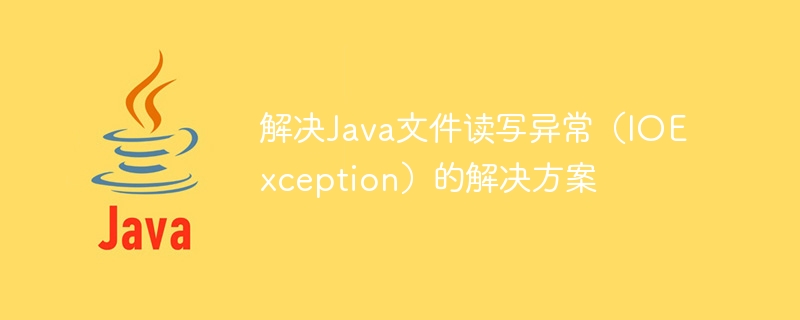解决Java文件读写异常(IOException)的解决方案

解决Java文件读写异常(IOException)的解决方案
在Java的文件读写操作中,经常会遇到IOException异常,这是由于文件读写过程中发生了一些错误导致的。在开发Java应用程序时,我们需要处理这些异常,以确保程序的稳定性和可靠性。本文将会提供一些解决方案,帮助开发者处理Java文件读写异常。
- 检查文件路径和权限
首先,我们需要检查文件的路径和权限。确保文件路径是正确的,并且程序对文件具有读写权限。如果路径不正确或者没有足够的权限,就会抛出IOException异常。
下面是一个例子,演示如何检查文件路径和权限:
try {
File file = new File("path/to/file.txt");
if (!file.exists()) {
throw new FileNotFoundException("File does not exist");
}
if (!file.canRead()) {
throw new IOException("Cannot read file");
}
if (!file.canWrite()) {
throw new IOException("Cannot write to file");
}
// 文件读写操作
} catch (FileNotFoundException e) {
e.printStackTrace();
} catch (IOException e) {
e.printStackTrace();
}- 使用try-with-resources语句
在Java 7及以上的版本中,可以使用try-with-resources语句来自动关闭文件流,避免资源泄露的问题。try-with-resources语句会自动调用流的close()方法,释放资源。
下面是一个例子,演示如何使用try-with-resources语句:
try (BufferedReader reader = new BufferedReader(new FileReader("path/to/file.txt"))) {
// 文件读操作
} catch (IOException e) {
e.printStackTrace();
}在这个例子中,BufferedReader对象会在try语句块结束后自动关闭,不需要我们显式调用close()方法。
- 使用缓冲流
在文件读写操作中,使用缓冲流(BufferedInputStream、BufferedOutputStream、BufferedReader、BufferedWriter等)可以提高读写性能。缓冲流会将数据存储在内存中,减少了对硬盘的直接读写操作,从而提高了效率。
下面是一个例子,演示如何使用BufferedReader来读取文件内容:
try (BufferedReader reader = new BufferedReader(new FileReader("path/to/file.txt"))) {
String line;
while ((line = reader.readLine()) != null) {
System.out.println(line);
}
} catch (IOException e) {
e.printStackTrace();
}- 处理文件编码问题
在进行文件读写操作时,需要注意文件的编码格式。如果使用了错误的编码格式,就会导致读取乱码或写入乱码的问题。可以通过指定正确的编码格式,解决这个问题。
下面是一个例子,演示如何通过指定编码格式来读取文件内容:
try (BufferedReader reader = new BufferedReader(new InputStreamReader(new FileInputStream("path/to/file.txt"), "UTF-8"))) {
String line;
while ((line = reader.readLine()) != null) {
System.out.println(line);
}
} catch (IOException e) {
e.printStackTrace();
}在这个例子中,使用了UTF-8编码格式来读取文件内容。可以根据实际情况选择合适的编码格式。
总结:
通过以上几种解决方案,我们可以有效地处理Java文件读写异常(IOException)。在开发Java应用程序时,我们需要多加注意文件路径、权限、使用try-with-resources语句、使用缓冲流和处理文件编码等问题,以提高程序的稳定性和可靠性。
希望本文提供的解决方案能够帮助开发者更好地处理Java文件读写异常。
以上是解决Java文件读写异常(IOException)的解决方案的详细内容。更多信息请关注PHP中文网其他相关文章!

热AI工具

Undresser.AI Undress
人工智能驱动的应用程序,用于创建逼真的裸体照片

AI Clothes Remover
用于从照片中去除衣服的在线人工智能工具。

Undress AI Tool
免费脱衣服图片

Clothoff.io
AI脱衣机

AI Hentai Generator
免费生成ai无尽的。

热门文章

热工具

记事本++7.3.1
好用且免费的代码编辑器

SublimeText3汉化版
中文版,非常好用

禅工作室 13.0.1
功能强大的PHP集成开发环境

Dreamweaver CS6
视觉化网页开发工具

SublimeText3 Mac版
神级代码编辑软件(SublimeText3)

热门话题
 突破或从Java 8流返回?
Feb 07, 2025 pm 12:09 PM
突破或从Java 8流返回?
Feb 07, 2025 pm 12:09 PM
Java 8引入了Stream API,提供了一种强大且表达力丰富的处理数据集合的方式。然而,使用Stream时,一个常见问题是:如何从forEach操作中中断或返回? 传统循环允许提前中断或返回,但Stream的forEach方法并不直接支持这种方式。本文将解释原因,并探讨在Stream处理系统中实现提前终止的替代方法。 延伸阅读: Java Stream API改进 理解Stream forEach forEach方法是一个终端操作,它对Stream中的每个元素执行一个操作。它的设计意图是处
 Java程序查找胶囊的体积
Feb 07, 2025 am 11:37 AM
Java程序查找胶囊的体积
Feb 07, 2025 am 11:37 AM
胶囊是一种三维几何图形,由一个圆柱体和两端各一个半球体组成。胶囊的体积可以通过将圆柱体的体积和两端半球体的体积相加来计算。本教程将讨论如何使用不同的方法在Java中计算给定胶囊的体积。 胶囊体积公式 胶囊体积的公式如下: 胶囊体积 = 圆柱体体积 两个半球体体积 其中, r: 半球体的半径。 h: 圆柱体的高度(不包括半球体)。 例子 1 输入 半径 = 5 单位 高度 = 10 单位 输出 体积 = 1570.8 立方单位 解释 使用公式计算体积: 体积 = π × r2 × h (4
 如何在Spring Tool Suite中运行第一个春季启动应用程序?
Feb 07, 2025 pm 12:11 PM
如何在Spring Tool Suite中运行第一个春季启动应用程序?
Feb 07, 2025 pm 12:11 PM
Spring Boot简化了可靠,可扩展和生产就绪的Java应用的创建,从而彻底改变了Java开发。 它的“惯例惯例”方法(春季生态系统固有的惯例),最小化手动设置











